How to choose a flowing water heater: an overview of the types of “flowers” and tips for customers
Agree, it’s great when hot water always flows from the tap, regardless of how it is supplied by the city utility. The problem of interruptions will help to solve the installation of instantaneous water heater. But the variety of offers on the market is amazing, and you want to buy the best model and don’t know which one to prefer?
We will show you how to choose a instantaneous water heater that has the necessary technical characteristics. We’ll tell you how to choose it taking into account operating conditions. We indicate what capabilities should be equipped with equipment to meet the individual needs of users.
The article discusses the main criteria for choosing the optimal model, provides a rating of the most popular water heaters. Attached are photo materials and useful video recommendations that will help determine the best streamer.
The content of the article:
Design and principle of operation
The device of a instantaneous water heater is not complicated: in a metal or plastic case there is a small water tank equipped with heating elements or a spiral.
In budget devices, most often 1-2 heating elements, which have a weak spot: heating elements quickly “overgrow” with scale. On the plus side, they are easy to replace.
Less scale is formed in appliances with a spiral enclosed inside a copper tube. The disadvantage of this device is a negative reaction to bubbles and air jams. If the equipment fails, replacement is expensive.
The principle of heating is simple: cold water enters the tank, comes into contact with hot elements, heats up and goes outside with the required temperature parameters (on average from + 40 ° C to + 60 ° C).
For the installation of compact equipment, you need a mounting kit, a water supply and an electric cable.
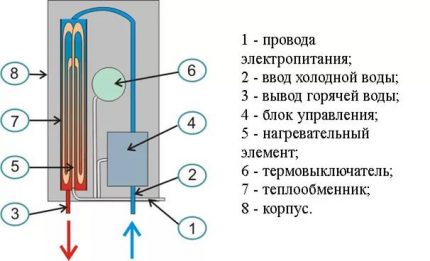
Powerful equipment designed for several points of drawdown requires good flow and high pressure. Low-pressure devices operating at low pressure can sufficiently serve only one crane.
For this reason, they are initially equipped with "custom" devices - a gander or a flexible hose with a diffuser.
The heating process occurs instantly, so you do not need to wait until a certain amount of hot water has accumulated. Electricity is consumed only during operation of the device.
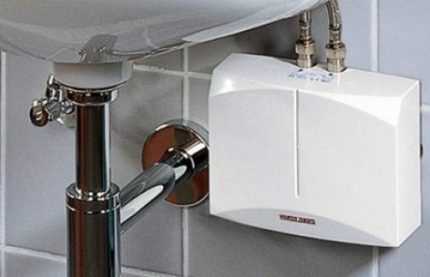
If we compare flow models with accumulative ones, we can distinguish the following advantages:
- space saving, compact size (important for rooms with a lack of free space);
- the ability to install both near the crane (minimizing heat loss), and in a separate room (applies to powerful appliances);
- the amount of water consumed is not limited;
- interval electricity consumption (only in the active period);
- beautiful concise design;
- low cost.
The disadvantages include regular expenses for paying for electricity: the more often the water heater turns on (respectively, the larger the family), the higher the electricity bill.
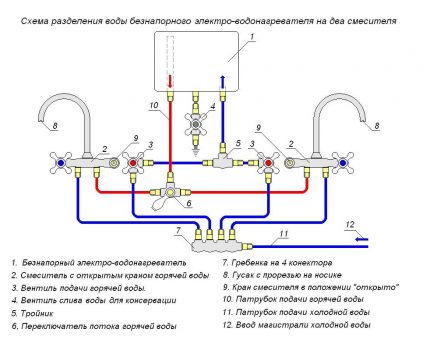
Another minus concerns the installation conditions. For water heaters with a capacity of 7-8 kW and above, a reliable three-phase electric network, high-quality copper wiring and appropriate protection are required.
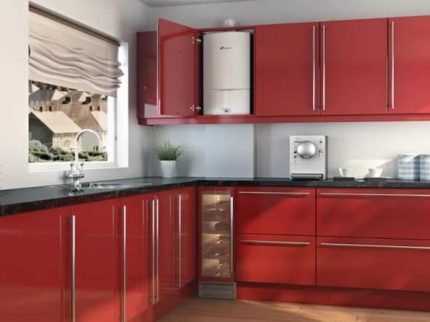
What makes an electric model better than a gas one?
In urban apartments, you do not have to choose between the two types of devices, since they usually use electric, safer models.
The exception is apartments in which gas water heaters are installed in the process of equipping the premises when the house is commissioned. This applies to the "Khrushchev", "Stalin" and some types of panel houses built in the 60-70s of the last century.
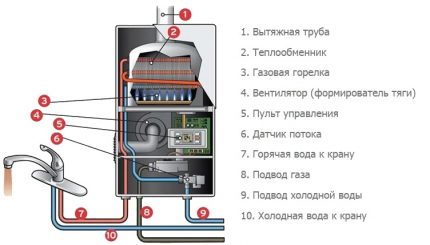
In suburban homes, water is more often heated with the help of a powerful floor-standing boiler, but some people prefer to use a geyser out of habit.
Its use is appropriate for stove heating or in a warm climate that does not require the installation of heating equipment.
Considered safer electric grooves, although their operation is more expensive than the use of gas columns. In addition, with gas heating, hood and reliable ventilation are mandatory, otherwise there will be a risk of carbon monoxide poisoning. Savings are considered a plus, since gas prices are lower than on electricity.
In houses of the old construction, it is not possible to use a powerful electric type device (above 3.5 kW), so you will have to do with a weak water heater, or gas column. Thus, if there is a choice, consider the condition of the electrical networks and ventilation, water pressure, and the cost of fuel (gas or electricity).
With landmarks choosing a water heater We invite you to read the article devoted to these issues.
Differences between pressureless and pressure devices
The difference between a non-pressure device is that the pressure inside it does not exceed atmospheric, while a pressure water heater always experiences the pressure of the main water.
A non-pressure device from the pressure of tap water protects the tap installed at the inlet. Models of this type have low power (2-6 kW), do not provide sufficient heating of water and are most often used in cottages or in houses of temporary residence.
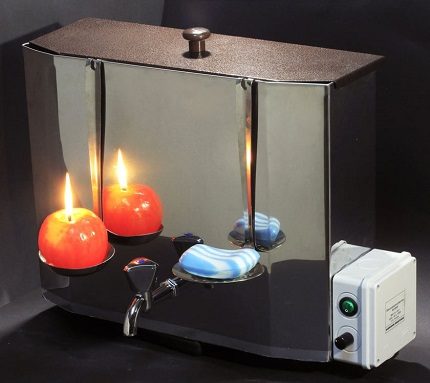
The pressure head device has no nozzles and is a mini boiler with input and output. One device can be connected simultaneously to several points of analysis.
Their capacity is enough to provide hot water and a kitchen sink, shower, and a couple of taps. There are 2 categories of pressure devices - single-phase (3-12 kW) and three-phase (3-30 kW).
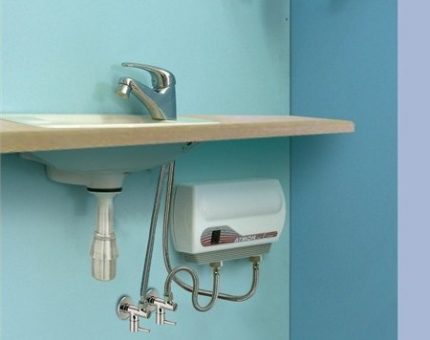
The disadvantages of a pressure head device are a higher price and increased energy consumption, but during a hot water outage in a city apartment in which a large family lives, you can not do without it.
Features of the choice of flow models
Due to the diverse requirements of users and the high demand for water heating devices, the market is filled with models with different technical characteristics.
To decide which of the instantaneous water heaters provided is better and more suitable specifically for you, pay attention to criteria such as power, performance and the presence of additional functions.
Criterion # 1 - power and performance parameters
Power is a decisive criterion that affects the amount of hot water heated over a certain period of time. If you need to take a quick shower or make dinner, a low-power appliance is enough to heat 3-5 liters of water for a minute.
Heating is carried out quickly, in just 20-25 seconds. With increased needs, we recommend taking a closer look at more powerful models.
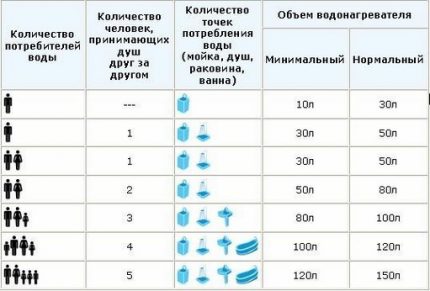
To calculate the power, you can use the generally accepted formula:
P = Q x (t1 - t2) x 0.073,
Where:
- P (W) - power;
- Q (l / min) - duct of hot water;
- t1 (° C) - the required temperature of hot water;
- t2 (° C) - water temperature in the water supply;
- 0,073 - correction factor.
In order not to make complex calculations, look at the manufacturer's recommendations - the purpose of the water heater is usually indicated there.
For example, devices with power up to 8 kW are recommended to be installed in cottages where there is no need for constant heating. An average temperature of 40-50 ° C is enough to quickly wash or wash several plates.
If you want to buy a serious device for the constant maintenance of your home or apartment, consider models with a capacity of at least 20 kW. When choosing, try to take into account the installation location of the points of tapping.
If the shower and the sink are close by through the wall, it is possible to install one product, far from each other - you will have to buy two low-power devices or one more powerful pressurized water heater.
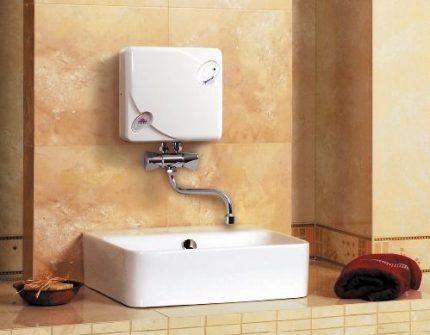
A few words about the weakest models, whose power does not exceed 3-4 kW. They are designed mainly for use in the warm period, when the average water temperature in the highway is 18-20 ° C.
If you want to take a hot shower in the winter (just at a time when accidents often happen), choose models with a capacity of 6 kW or more.
The power and performance of the device are indicated in the technical data sheet of the products, as well as on the price tags in the explanatory descriptions. On the sites of online stores, the exact data can be found in the "Specifications" section.
Criterion # 2 - control types and modes
Despite the simplicity of the design, according to the type of control, flow-through models are divided into two categories:
- hydraulic;
- electronic.
Hydraulic (or mechanical) control typical for all models of the budget class. Usually it is presented as a step switch. Some models do not have the ability to adjust the temperature or water pressure.
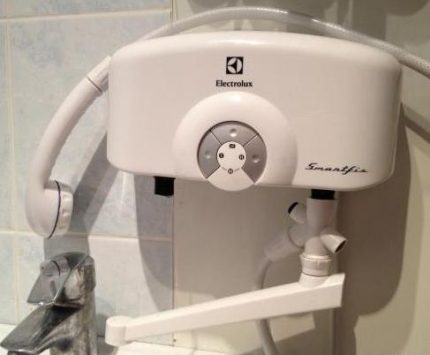
The control principle is as follows. Levers or buttons located in an accessible place on the body actuate the stem. Depending on the position of the stem, the pressure of the water may change, and as a result, the temperature.
The main drawback of this type of model is the lack of precise adjustment and maintaining a constant mode. If the water pressure in the line is weak, the device may not turn on at all.
Via electronic gear management You can set the required water pressure or maximum heating.
Built-in microprocessors and sensors respond to pressure and temperature changes, changing the parameters according to the selected mode. Using various modes, you can select the optimal parameters in order to save energy.
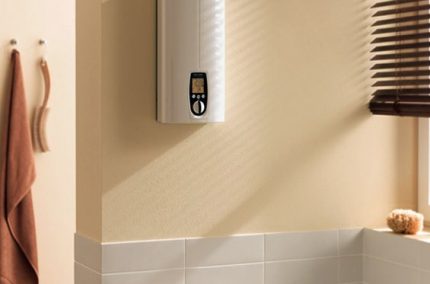
The disadvantage of electronically controlled models is the high price, the main advantage is the ability to select the desired mode (maximum, minimum, economical).
Mechanical control is permissible when the device is installed to service one shower or one sink - at any time you can use the switch and change the parameters. Electronic control is good in cases where one pressurized water heater serves several draw points.
Criterion # 3 - availability of additional options
The design of budget models is simple, since they do not have additional functions, but equipping electronics with more expensive models makes users' lives much more comfortable.
When choosing, pay attention to such characteristics as:
- several power modes;
- indication of inclusion and heating;
- overheat protection;
- temperature limitation (maximum and minimum);
- hard water protection;
- protection against a scum;
- check valve;
- programming function.
The listed characteristics are characteristic of middle-class models worth 15-20 thousand rubles. With expensive appliances, you can find more interesting, narrowly targeted options. For example, many AEG-branded products are suitable for connection to solar panels - inlet heating up to +60 ° C.
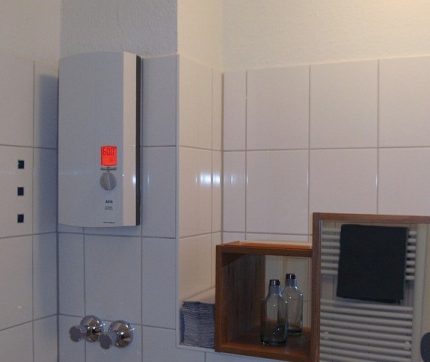
The German company Stiebel Eltron produces models in which, in addition to the already familiar lock from children (a rare protection specifically for water heaters), there is a set of useful programs, including 4 contrast shower modes.
Geyser selection criteria according to water consumption and personal requirements given here.
Wall Mount Features
Instantaneous water heaters are installed in a convenient place for control, most often on the wall near the sink or shower. For fastening to concrete panels or brick walls using dowels, to drywall (not recommended) - special devices of the "moth" type. The product should be located according to the instructions, it is impossible to turn.

Electrical connection must be made through RCD, especially if the manufacturer does not provide a protective automatic shutdown function.
A three-core copper cable is pulled from a common shield with ground, then either a differential switch or a circuit breaker is installed.
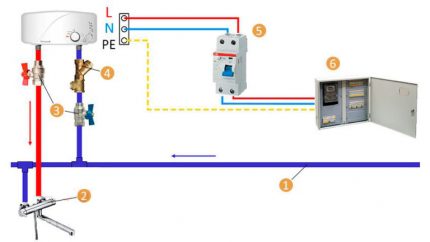
It is better to equip the inlet pipes for the pressure water heater with ball valves - for the convenience of mounting / dismounting. Remember that a non-pressure device has only one branch pipe - for connecting cold water.
More details with the rules installation of grooving You can familiarize yourself with the article presented to your attention.
Rating of famous manufacturers
The main criteria by which products of well-known manufacturers are evaluated are quality, warranty period, standard functions, availability of additional options, variety of models.
The price of products can be ignored, since each manufacturer has a line of low, medium and high price categories.
Place # 1 - Stiebel Eltron
The German company Stiebel Eltron, producing impeccable equipment with a 3-year warranty. Known for the release of powerful pressure water heaters with a set of additional functions. Easy installation and ease of operation, many convenient modes, temperature and pressure adjustment are outstanding qualities plus German reliability.
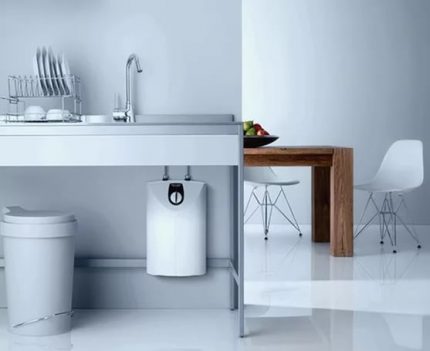
Place # 2 - AEG
The German manufacturer AEG, which has established itself with excellent product quality. Devices serve for a long time and get to service centers for repairs extremely rarely.
In Russia, a line of single-phase devices from the "mini" series has become popular, compact and economical.
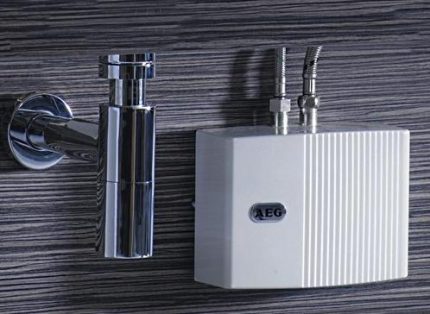
Place # 3 - Electrolux
The Swedish company Electrolux, known for a variety of mid-range models.
Compact, but quite powerful devices are cheaper than German counterparts due to the use of less reliable materials in the design. Most of the products are made in China.
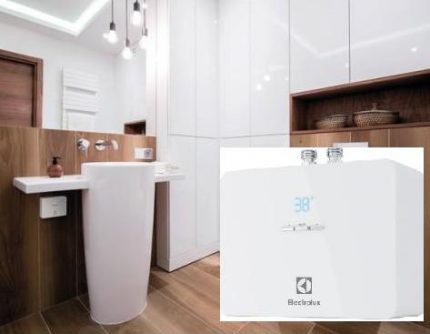
Place # 4 - Atmor
Israeli brand Atmor, producing low-cost devices for home and garden. Compact devices with mechanical control have several operating modes, well debugged automation and protection against overheating.
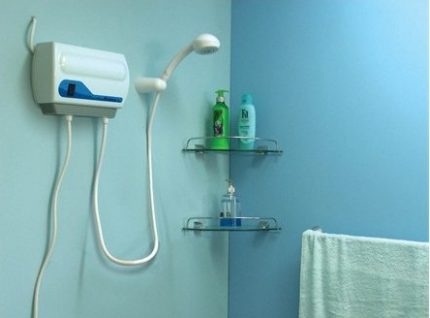
Place # 5 - Timberk
Swedish company Timberk, which produces several series of low-cost instantaneous water heaters. The popular Primalux and Watermaster ranges. The devices are not demanding on water pressure, have compact dimensions and modern design.
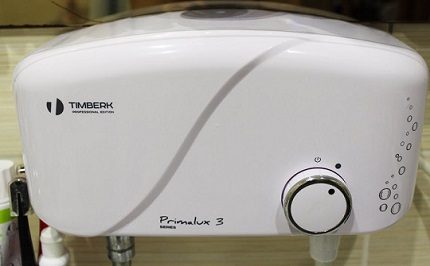
The listed models are popular in Russia and are available in the assortment of many online stores. Prices may vary depending on the exchange rate and the marketing concept of the selling company.
Conclusions and useful video on the topic
A few useful tips presented in the videos will help you make your choice.
The subtleties of choosing a flow-through type of water heater are discussed in the following video:
Useful information about the design and principle of operation of instantaneous water heaters:
Power calculation options:
Timberk Watermaster Series Overview:
As you can see, the choice of instantaneous water heaters is quite wide. Before buying, determine the power, consider models from different manufacturers, take an interest in the availability of additional options and purchase a device that best suits your requirements.
If you have questions - contact sales consultants and carefully read the instructions.
Please comment on the material that we submitted for consideration in the block below. Here you can ask a question, as well as share personal experience in the selection and operation of a instantaneous water heater.

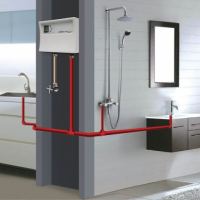 Instantaneous electric water heater for a shower: types, selection tips and an overview of the best manufacturers
Instantaneous electric water heater for a shower: types, selection tips and an overview of the best manufacturers 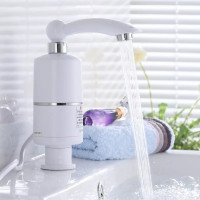 Which water heater is better - flow or storage? Comparative review
Which water heater is better - flow or storage? Comparative review 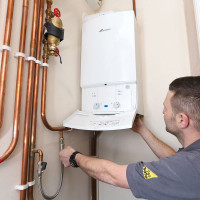 Gas water heaters: TOP-10 of the best models + tips for choosing equipment
Gas water heaters: TOP-10 of the best models + tips for choosing equipment 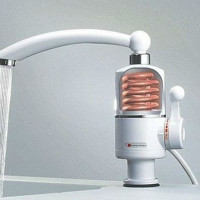 Electric instantaneous water heaters: TOP-12 popular water heaters + recommendations for customers
Electric instantaneous water heaters: TOP-12 popular water heaters + recommendations for customers 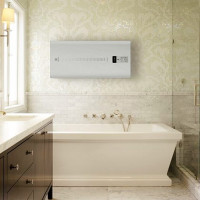 How to choose a storage water heater: which is better and why, what to look at before buying
How to choose a storage water heater: which is better and why, what to look at before buying 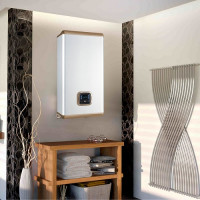 Which water heater to choose: determining the best equipment + model rating
Which water heater to choose: determining the best equipment + model rating  How much does it cost to connect gas to a private house: the price of organizing gas supply
How much does it cost to connect gas to a private house: the price of organizing gas supply  The best washing machines with dryer: model rating and customer tips
The best washing machines with dryer: model rating and customer tips  What is the color temperature of light and the nuances of choosing the temperature of the lamps to suit your needs
What is the color temperature of light and the nuances of choosing the temperature of the lamps to suit your needs  Replacement of a geyser in an apartment: replacement paperwork + basic norms and requirements
Replacement of a geyser in an apartment: replacement paperwork + basic norms and requirements
In general, a flowing water heater is a thing! Although all my acquaintances are somehow afraid to put such ones, they say, it will be expensive to go out. And hang up funded. But I personally wouldn’t want 80 liters of boiling water hanging over me. But not the point. Here we have a problem house - they built it, then the developer went bankrupt, and now for 10 years we have been connected to water by some kind of left-hand temporary circuit. But only to cold, no hot. Well, what was to be done, of course, they installed flowing heaters both in the bathroom and the kitchen. Well, yes, electricity is expensive, but we have hot water (and boiling water, and not barely warm, like everywhere else) all year round! No outages and basins. I’m already used to them, I don’t know how we would be without heaters.
I used to be skeptical about instantaneous water heaters. In our private house stood and costs an accumulative version of 80 liters. We used the whole family - we were 3 people, and we had enough. And more recently, my mother moved to another apartment, and there is no hot water at all. We set her running. She lives alone, she has enough of this water heater with her head. Yes, electricity consumption per month increased, but there is no need to manually heat water. She needs one to bathe and wash the dishes.